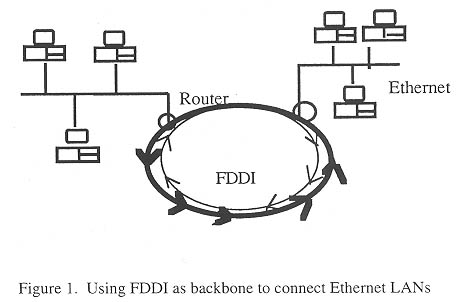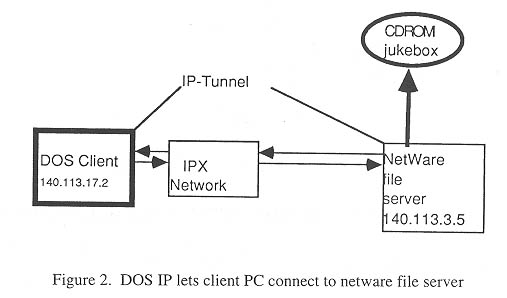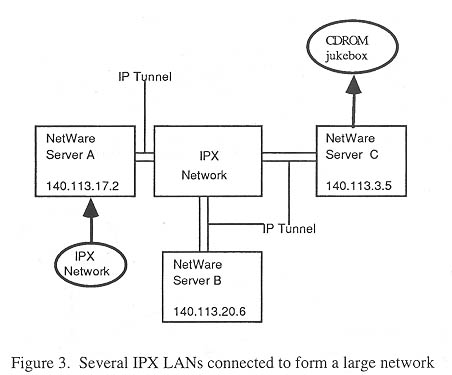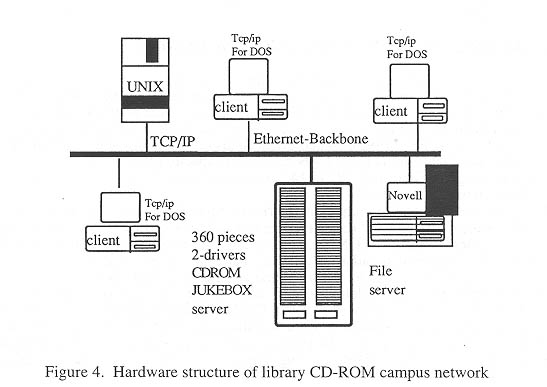
A NEW METHOD FOR MULTI-USER ACCESS TO LIBRARY CD-ROM JUKEBOX DATABASE VIA CAMPUS NETWORK
Ruey-Shun Chen
Institute of Information Management
Y. S. Yeh
Institute of Computer Science and Information Engineering
National Chiao Tung University
Hsinchu, Taiwan, ROC.
E-mail: rschen@cc.nctu.edu.tw
E-mail: ysyeh@cc.nctu.edu.tw
This paper proposes a new method to solve this problem. It describes the practical design and implementation of a microcomputer and Novell server that allows multiuser access to library CD-ROM jukebox database via campus network. The method uses microcomputer via standard network interfaces like Ethernet, high speed fiber networks, and standard protocols TCP/IP and IP-tunnel. Its advantages are that it reduces waiting time, improves access speed, reduces the damage incurred by handing jukebox CD-ROM devices in and out, and Novell sever with network secure access control to allow many users to retrieving the jukebox CD-ROM from microcomputers.
CD-ROM provides enormous storage of about 600MBs, retrieval capacities, and reasonable price. It has been gradually replacing some of its printed counterparts. Most European and American universities have used CD-ROM databases since 1987. Library automation is a goal for many libraries. The utilization of CD-ROM in the library and information science areas goes back to 1985, when Bibiofile was announced by the library corporation. A survey of libraries in Taiwan has shown that currently 86% of academic libraries have CD-ROMs in their library collection (Shih, 1991).
As known, one of the greatest limitations in using stand-alone CD-ROM databases is that they can be accesses only on at a time (Martin, 1990); we have found a solution for this problem. But now we have a large amounts of image CD-ROMs such as IEEE/IEE Publication Ondisc (IPO), Business Publication Ondisc (BPO), and General Publication Ondisc (GPO). We have used jukebox to network them via campus network that can offer other benefits, such as facilitating searching of databases containing more than one disk (Ron, 1988). Several examples include: Dartmouth College Library has developed a system that uses modem login to file server to access an on-line database via a campus-wide network of Macintoshes, microcomputers and mainframe computers. The access to network CD-ROM database has restricted the library's involvement in CD-ROM; the latter has been effectively leapfrogged in favor of the network (Finnegan, 1990). Miami University libraries have an Ethernet local area network to provide multiuser access to multiple CD-ROM databases through selected workstations in the libraries. Dial-up access will be available to users outside the libraries (Chen, 1989). Multiplatter is a CD-ROM local area network that allows multiple users to access the same CD-ROM disc simultaneously. The first test site was Boston College.
Computer networks offer several advantages over single-processor systems. It provides resource sharing, increased reliability, distributing the workload and expandability. So it is important to develop a library CD-ROM campus networking system that meets the standard network protocols such as Ethernet, FDDI and TCP/IP in order to implement a practical system for sharing CD-ROM resources.
In this research, we propose a method that allows endusers to use microcomputers to access a library full-text image CD-ROM jukebox database, and use remote login NOVELL file server through computer network. In Section 2, we introduce the types of library CD-ROM jukebox networking. In Section 3, we show how to provide network access to the library CD-ROM jukebox database from the campus network. In Section 4, we show the practical design of a library CD-ROM campus networking system for use at National Chiao-Tung University in Taiwan. Section 5 shows performance evaluation and discussions.
2. THE TYPES OF LIBRARY CD-ROM JUKEBOX NETWORKING
Figure 1 shows a library CD-ROM campus network environment. Inside the building Ethernet is used while FDDI is used between buildings to communicate with each other. The following shows some kinds of communication modules (Wan, 1991).

2.1. Connect Personal Computer to File Server
PCs in the client part run ipx software. The file server part runs on a pentium PC and connects the CD server. This communication module is suitable only for a Local Area Network (LAN) inside the library.
2.2. Connect personal computer to Local Area Network
This is the most usual solution for campus networks, as shown in Figure 2. It is common because most libraries already have CD-ROM system connected to a LAN. A LAN usually needs one file server, which is dedicated to nothing but running the CD-connection software. The LAN will let you connect more CD drivers, and each user can access all of them. Figure 2 shows how DOS-clients can use LAN-workplace for DOS, IPX, TCP/IP and IP-tunnel software through routers, to remote server and release IPX to CD-ROM file server. This is our design model for a library jukebox CD-ROM campus networking system.

2.3. Local Area Network to Local Area Network
Some LANs can be used to build a large network through routers or bridges as shown in Figure 3. The advantage is that a large network has several file servers using TCP/IP protocol to communicate with each other. So in a network environment with router, each LAN's file server has a running program, and a database is stored in each LAN. When another LAN's database is needed, resources may be shared through a router into another LAN's server. Figure 3 shows this idea and also applies it to library CD-ROM jukebox campus network.
3. ACCESS THE LIBRARY CD-ROM JUKEBOX VIA CAMPUS NETWORK
Theoretically, if the LAN file server is connected to the Ethernet and defined as a node on the network, any remote PC with an Ethernet card running TCP/IP should be able to access it directly from the campus network. The LAN software will provide access to CD-ROM jukebox. It performs a logical mount and will only do this for a "computer" not a "terminal". If it is running MSCDEX.EXE plus CD networking software, it can provide access to an optical drive just as it does to a magnetic drive. The following are some options (Jull, 1992).

3.1. Personal Computer Access to Library CD-ROM Jukebox via LAN in Library
This is the most usual solution inside of a library. A PC uses IPX software connected to NOVELL file server. Many users can attach to the CD-ROM jukebox, but only one can access it simultaneously. It is suited for local area networks inside a single building.
3.2. CD-ROM Drives Is Running on NFS
NFS is a public-domain networking software system. It has two parts: the server-part which manages the CD-ROM jukebox, and the client-part which tries to access the CD-ROM jukebox from the campus network. Any PC connected to the network and running the client version of NFS can access the CD-ROM jukebox, which is connected to SUN/UNIX running the server part of NFS.
4. PRACTICAL DESIGN STRUCTURE
4.1. Hardware Implementation
We applied DOS-client to NOVELL file server as in Figure 2 and NOVELL file server to server as in Figure 3 for campus network system. The users must have a personal computer with Ethernet card and a LAN work-place for DOS software. Mounted software maps any networked CD-ROM jukebox to logical drive on the modulation with minimum memory usage. The users can access to one or more CD-ROM jukeboxes from campus network. Simultaneously, multiuser access to CD-ROM jukebox is possible through the connection to the NOVELL file server, in-house archiving of documents and spoolout data. The hardware structure in Figure 4 is the library CD-ROM campus network of National Chiao-Tung University in Taiwan.

4.2. Software Implementation
Access principle in the enduser's personal computer runs LAN workplace for DOS IP-tunnel software through the campus network router into the library NOVELL file-server. A CD-ROM jukebox retrieval program is running through RS-232 to call the robot-arm to pick up the CD-ROM into jukebox driver, then the retrieving program copy. The needed image files through the NOVELL file server into enduser personal computer hard disk.
The steps of the campus network running program are:
Step 2: Set parameters of Ethernet card and link driver
Step 3: Load TCP/IP protocol
Step 4: Load IP-tunnel protocol
Step 5: Load IPXODI software
Step 6: Execute NETX attach to server
Step 7: Login file server and call CD-ROM running
program.
Step 2. Open CONTENTS.JUK file and initialize all the contents of the jukebox. If failed go to step 8.
Step 3. Check REQUEST.JUK and ACCOUNT.JUK files and open it.
Step 4. Get user requests, and write the requests into REQUEST.JUK file and make reservation for next user.
Step 5. Clear the reservation of the current user, load disk and check disk for the current user. If error, then go to step 8.
Step 6. Copy requested article for the current user.
Step 7. Take next user as current user. Then go to step 4.
Step 8. Exit.
To analyze the performance of a CD-ROM campus networking system, we assume that the FDDI backbone's circumference is equal to the maximum distance, i.e., 200km. The FDDI backbone runs at 100bps and each of its Ethernet-like local area networks runs at 10 Mbps. The ordinary delay for one FDDI station is 600ns and the total delay for the 200km-long ring cable is 1.017 ms (Chen, 1986). Theoretical analysis calls on each Ethernet-like LAN concurrently, but each Ethernet-like LAN has also a capacity limit on the number of remote PCs. By reducing this limit from 281 to 140, we can increase the maximum number of FDDI routers from 10 to 21 (Yu, 1990).
From the above data, the campus network can support 100 users accessing the library CD-ROM jukebox database but only one user can access a specific CD-ROM at one time. Though it is a single user CD-ROM jukebox, access time averages only 30 seconds for one user. CD-ROM jukebox is popular for all users, because the dedicated server can overcome the slow access time of the CD-ROM drive, and can allow multiple users to access the same CD-ROM without appreciable delay. Large cache memory capability is available through the CD-ROM server, which reduces physical CD-ROM access and boosts access speed for remote users. Data can be read from all drives simultaneously, thus dramatically increased performance during heavy usage. To improve retrieval time performance, CD-ROM disk caches are frequently used. Disk caching lowers overall retrieval time by transferring information from RAM instead of from CD-ROM.
When we compare the performance of a non-network workstation to the performance of a twenty-concurrent-users CD-ROM system, the worst case lag time for full screen VGA graphs was approximately double for CD-ROM system. In addition, through library CD-ROM campus networks can increase retrieval speeds by running multiple copies of the same CD-ROM in different research rooms. This system offers high performance that allows multiple users to share a CD-ROM database.
6. CONCLUSION
In this paper we design an Ethernet-Router-FDDI for a CD-ROM campus network system which can allow faculty and graduate students to access library CD-ROM database from their own office. Theoretical analysis modules and practical design structure for a campus network have been proposed for the system. From analysis, we know that our scheme is secure not only for the computer system, but also for the users. The results of our library CD-ROM campus networking system have been very positive. It offers a practical high performance way to provide multi-user access to the full text image CD-ROM data. It also permits access to multiple copies of the same CD-ROM database for increased performance.
For further study, we may connect a group of universities
using modems to build a wide area campus networking system that will share
library CD-ROM resources.
REFERENCES
Chen, C. (1986). FDDI-Token Ring Media Access Control. ANSIX3T9.
Chen, C. C. (1989). Beyond the online public access catalog: one step electric access to information. Proceeding of the 2nd Pacific Conference on New Information Technology for Library. Newton, MA: MicroUse Information. pp. 359-p364.
Cwan, C. (1991). WAN. Remote Operating Magazine Chinese Version, pp. 141-143.
Finnegan, G.A. (1990). Wiring in information to a college campus: A port for every pillom. Online, 14 (2): 37-40.
Grant, M. A. (1989). The multiplotter CD-ROM network at Boston College. Laserdisk Profes-sional, 2 (5): 12-18.
Jull, K. (1992). Networking CD-ROM via a LAN. CD-ROM Professional, pp. 83-90.
Martin, K. (1990). CD-ROM network. Wilson Library Bulletin, 64 (5): 83-84.
Ron, J. R. (1988). Creation and distribution of CD-ROM database for the library reference Desk. Journal of American Society for information science, pp. 37-62.
Shih, M.Y. (1991). The utilization of CD-ROM in the academic library in Taiwan. Journal of Library Science, 28 (3): 331-344.
Yu, C.S. A protocol for Integrating voice and data
on FDDI/Ethernet interconnect networks. International Telecommunication
Symposium, 1990, 469-476.